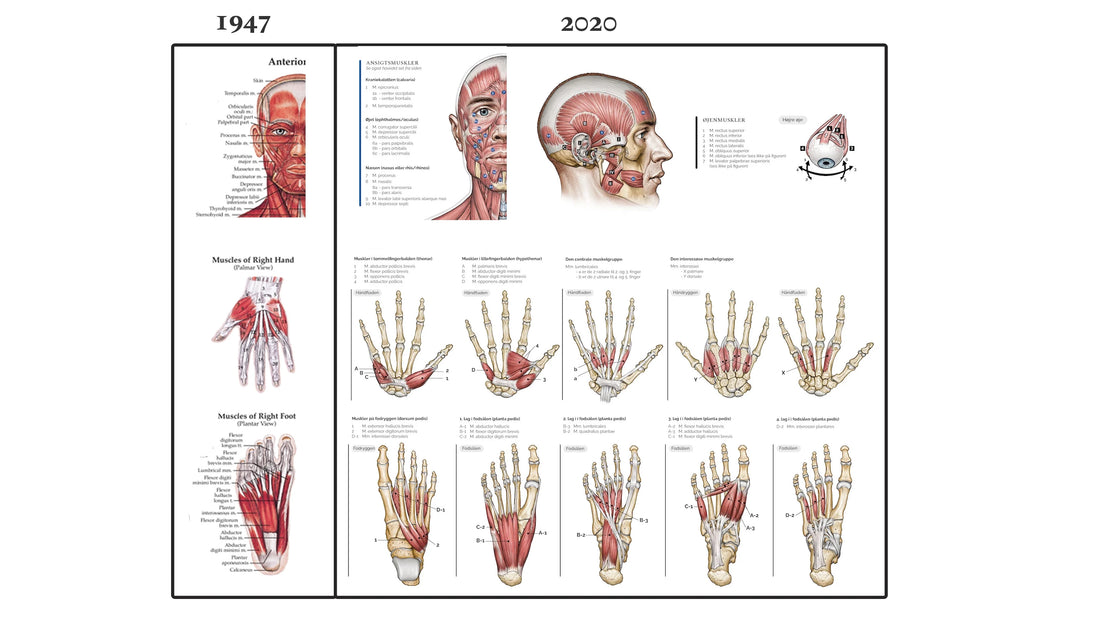
The classic muscle poster has been rethought and adapted for 2023
Share
Knowing what it takes to create something completely new in a field of interest that never seems to change is not done quickly. We spent 3 years designing and creating the poster EA1 - Musculoskeletal Anatomy, and during that process we felt the hardships and setbacks of the constant revisions and editions we had to go through before we finally reached our goals with the project.
The aforementioned is happily forgotten, as we once again set out to create a new poster, which this time will become the ultimate muscular system poster with a focus exclusively on muscles.
The purpose of rethinking what a muscle poster is is to create a solution to a problem that we always experience with the existing muscle posters on the market; We feel lost and completely and utterly frustrated by the total lack of structure, content in both text and visualization and therefore have no chance of getting the overview of the muscle groups, which is the goal of the learning.
The creation of the EA5 muscular system
The goal IS simple. We want to create a poster that does what a muscular system poster should do; namely to provide a logical overview of the location, name and grouping of the muscles in the form of an easy and logical overview both visually and in nomenclature, to hang on the wall.
The work begins
We start by clarifying the content and scope of the poster and recognize that we must include everything. Muscles must be grouped, the names must be written correctly and in the correct order and we must see the muscles. We first try to reuse the ideas from our work with the EA1 poster, e.g. the lines between text and illustration, but we find that it becomes a big mess. Instead, we invent a very simple but clever system, in our humble opinion, that basically uses systematic colors and groupings, leaving the illustrations clear, while at the same time catching the eye the connection between the colored numbers and groupings of muscle names. At the same time, we produce unique illustrations to visualize e.g. the muscles around the ribs or pelvis, just as we design a muscular figure with a high degree of detail and deep and superficial muscle layers.
When we're done, we take a hard look at all the existing muscle posters on the market that we've bandied about for so many years and compare them to the results of our work on the EA5 muscle system poster.
The 5 most important features of the EA5 muscle poster that distinguish it from existing muscle posters on the market are briefly:

1) All muscles in the human body can be grouped, which is important when learning and remembering them. On our poster, they are all grouped logically, so that there is no doubt to which muscle group each individual muscle belongs. Examples of these muscle groups are the masticatory muscles of the jaw, the neck muscle groups and the thigh muscle groups. The muscle groupings on the poster are completely identical to the muscle groupings in the textbooks used at medical schools in Denmark.
On older existing muscle posters, the muscles are not grouped and, for example, you cannot see that the brachioradialis muscle belongs to the extensor muscles of the forearm.
2) In many places on the poster, the muscles are also named and illustrated in their layers or so-called lodges. As an example, you can easily and quickly see the division of the neck muscles into layers (the superficial, the suprahyoid, the infrahyoid, the deep and the scalene muscles).
On older existing muscle plaques, layering is not seen.
3) A logical and educational learning system based on colors, precise numbering and visual aids makes it easy and quick to identify each individual muscle group with its different muscles as well as the display of these muscles on the poster's illustrations.
On older existing muscle posters, the muscles and their names are shown randomly using visually disturbing lines and often mixed up, which for example makes it very difficult to identify the 4 paired masticatory muscles easily and quickly. This means that efforts to identify all these masticatory muscles can take the form of "looking for a needle in a haystack".
4) Clinical details are included on the poster, such as, for example, in which directions the eye muscles move the eyeball, conditions in the rectus sheath regarding linea arcuata, the inguinal canal in men, the rotator cuff in the shoulder and what functions the muscles in the throat have (e.g. tension and relaxation of the vocal cords).
On older existing muscle posters, clinical details are not seen.
5) The poster comes in local language versions, where, for example, the Danish version has Naming of muscles written in pure Latin, and all headings contain Danish designations. Furthermore, explanatory text is written in Danish. The English version comes in plain English for both titles, explanatory texts and muscle names (Anglo-Latin).
That said, we think anyone who sets out to learn muscle and wants to keep their knowledge fresh in their memory will love our new Muscular System Poster.
